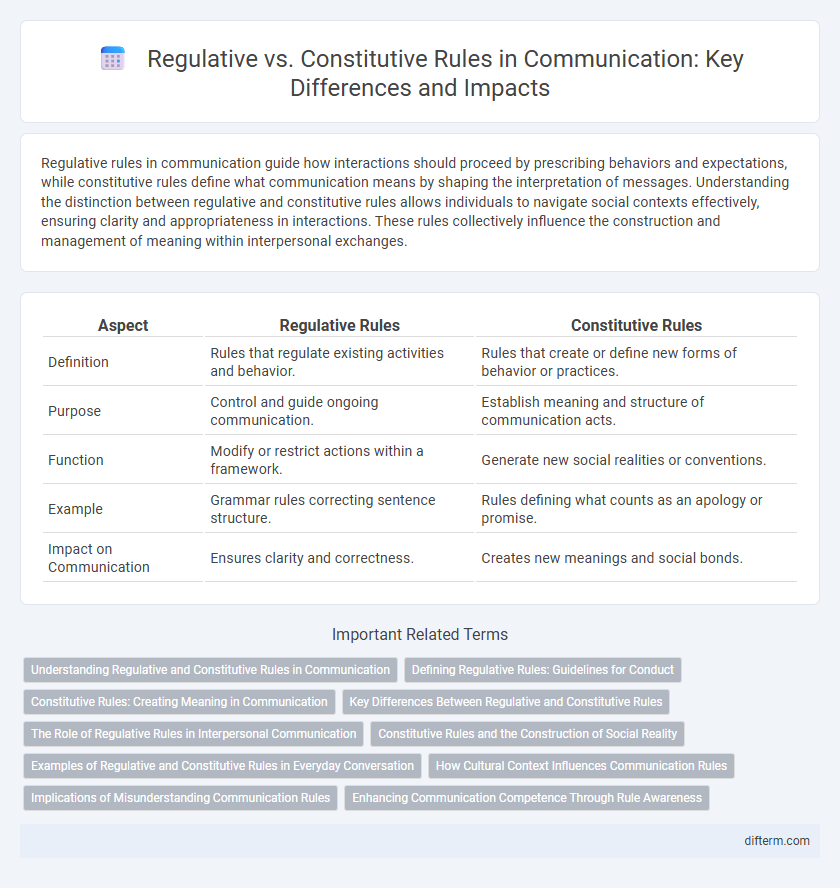Regulative rules in communication guide how interactions should proceed by prescribing behaviors and expectations, while constitutive rules define what communication means by shaping the interpretation of messages. Understanding the distinction between regulative and constitutive rules allows individuals to navigate social contexts effectively, ensuring clarity and appropriateness in interactions. These rules collectively influence the construction and management of meaning within interpersonal exchanges.
Table of Comparison
| Aspect | Regulative Rules | Constitutive Rules |
|---|---|---|
| Definition | Rules that regulate existing activities and behavior. | Rules that create or define new forms of behavior or practices. |
| Purpose | Control and guide ongoing communication. | Establish meaning and structure of communication acts. |
| Function | Modify or restrict actions within a framework. | Generate new social realities or conventions. |
| Example | Grammar rules correcting sentence structure. | Rules defining what counts as an apology or promise. |
| Impact on Communication | Ensures clarity and correctness. | Creates new meanings and social bonds. |
Understanding Regulative and Constitutive Rules in Communication
Regulative rules in communication dictate how participants should behave during interactions, outlining appropriate, permissible, or prohibited actions to ensure social order. Constitutive rules define the meaning of communicative behaviors, shaping the interpretation and construction of messages within specific contexts. Understanding both regulative and constitutive rules is essential for effective communication, as they guide behavior and interpret meaning simultaneously.
Defining Regulative Rules: Guidelines for Conduct
Regulative rules function as guidelines for conduct, directing how individuals should act in specific situations to maintain order and predictability in communication. These rules establish clear expectations by specifying permissible behaviors and boundaries within interactions. By adhering to regulative rules, communicators ensure clarity, reduce misunderstandings, and facilitate smooth social exchanges.
Constitutive Rules: Creating Meaning in Communication
Constitutive rules serve as the foundation for creating meaning in communication by defining how messages are interpreted within specific social contexts. These rules shape the structure of interactions, guiding what counts as appropriate or meaningful behavior, thus enabling participants to co-construct shared understanding. Unlike regulative rules that govern behavior, constitutive rules influence the very nature of communication by establishing the criteria for meaningful exchange.
Key Differences Between Regulative and Constitutive Rules
Regulative rules govern existing activities by specifying how individuals should behave in communication, such as norms for turn-taking and politeness. Constitutive rules define the very creation and interpretation of communication acts, shaping the meaning and structure of messages within social interactions. The key difference lies in regulative rules managing actions within communication, while constitutive rules establish what those actions signify and enable meaningful exchanges.
The Role of Regulative Rules in Interpersonal Communication
Regulative rules in interpersonal communication dictate the norms and guidelines that govern how individuals exchange messages, ensuring clarity and mutual understanding. These rules help manage turn-taking, politeness, and appropriateness within conversations, promoting effective and respectful interactions. By providing a structured framework, regulative rules reduce misunderstandings and facilitate smoother relational dynamics.
Constitutive Rules and the Construction of Social Reality
Constitutive rules define and create social realities by establishing the meanings and permissible actions within communication processes, shaping how individuals interpret and respond to interactions. These rules go beyond mere regulation by actively constructing the framework of social norms, identities, and relationships through language and symbolic behavior. Understanding constitutive rules illuminates how social order and shared meanings emerge dynamically within communicative contexts.
Examples of Regulative and Constitutive Rules in Everyday Conversation
Regulative rules in communication guide the flow of conversation by prescribing appropriate behaviors, such as taking turns speaking or maintaining eye contact, ensuring clarity and social harmony. Constitutive rules define the meaning of communication acts, like interpreting a raised eyebrow as skepticism or understanding sarcasm in a statement, shaping how messages are constructed and understood. In everyday conversation, saying "Excuse me" to interrupt illustrates a regulative rule, while recognizing that "Can you pass the salt?" is a request rather than a question demonstrates constitutive rules at work.
How Cultural Context Influences Communication Rules
Cultural context shapes communication rules by defining what is considered appropriate or inappropriate within a society, influencing regulative rules that guide behavior and constitutive rules that determine meaning. High-context cultures rely on unspoken norms and shared understandings, while low-context cultures emphasize explicit communication and clearly articulated rules. The variation in cultural communication styles impacts how messages are constructed, interpreted, and negotiated across different social environments.
Implications of Misunderstanding Communication Rules
Misunderstanding regulative communication rules, which govern how messages are exchanged, can lead to breakdowns in conversation and increased conflict. Confusion about constitutive rules, defining what communication means in specific contexts, often results in misinterpretation of intentions and social norms. These misunderstandings hinder effective interaction and damage relational trust in both personal and professional communication settings.
Enhancing Communication Competence Through Rule Awareness
Understanding the distinction between regulative and constitutive rules significantly enhances communication competence by providing clarity on how interactions are structured and created. Regulative rules dictate appropriate behavior in communication contexts, while constitutive rules define what communication means within specific social frameworks. Awareness of these rules allows individuals to navigate conversations effectively, interpreting messages accurately and responding appropriately to varied communicative situations.
regulative vs constitutive (rules) Infographic

 difterm.com
difterm.com